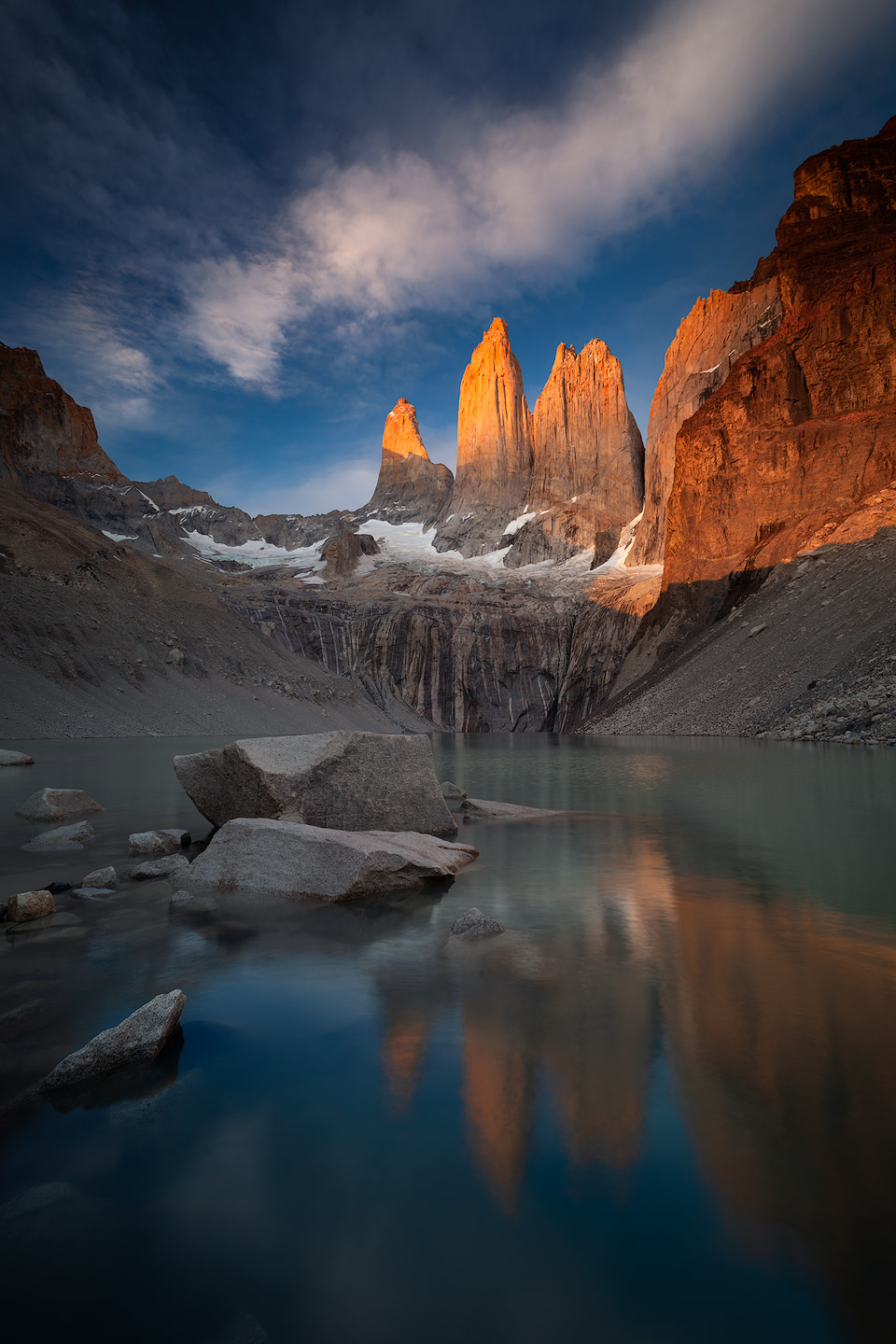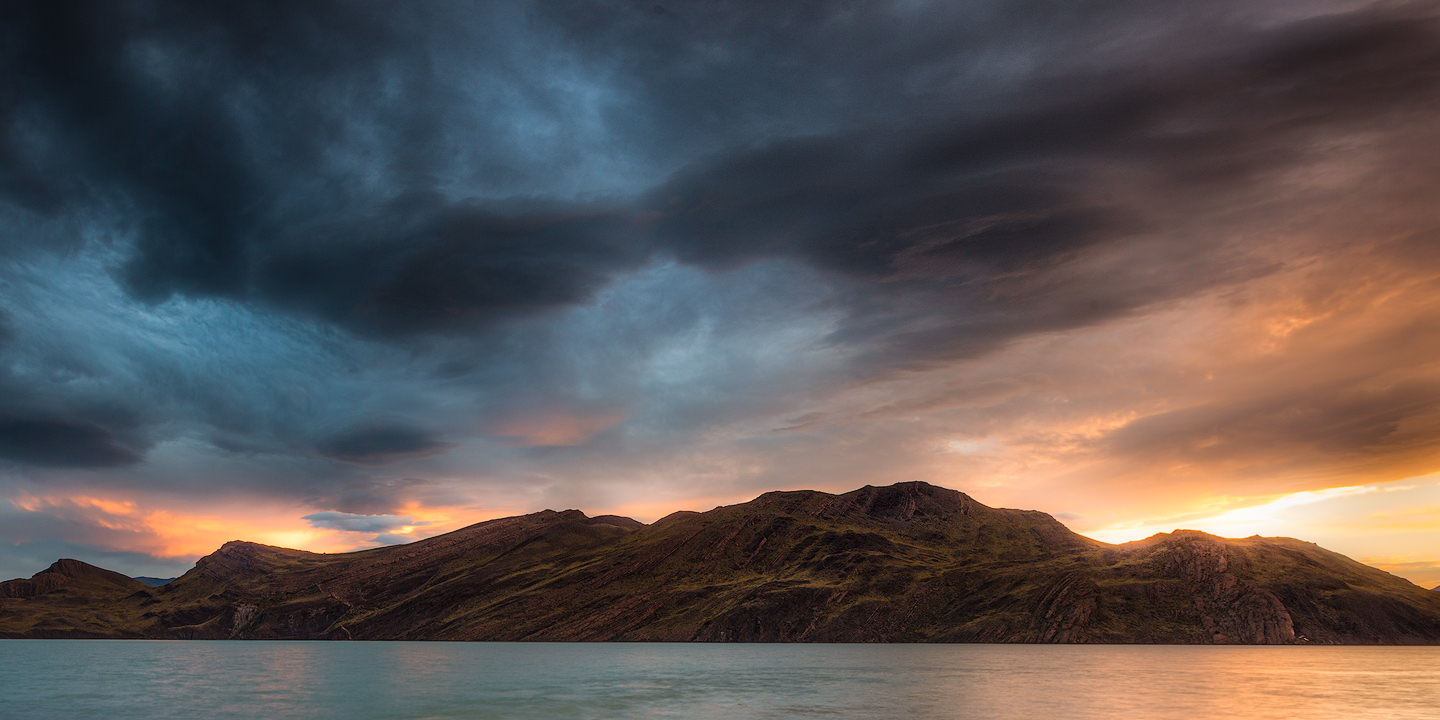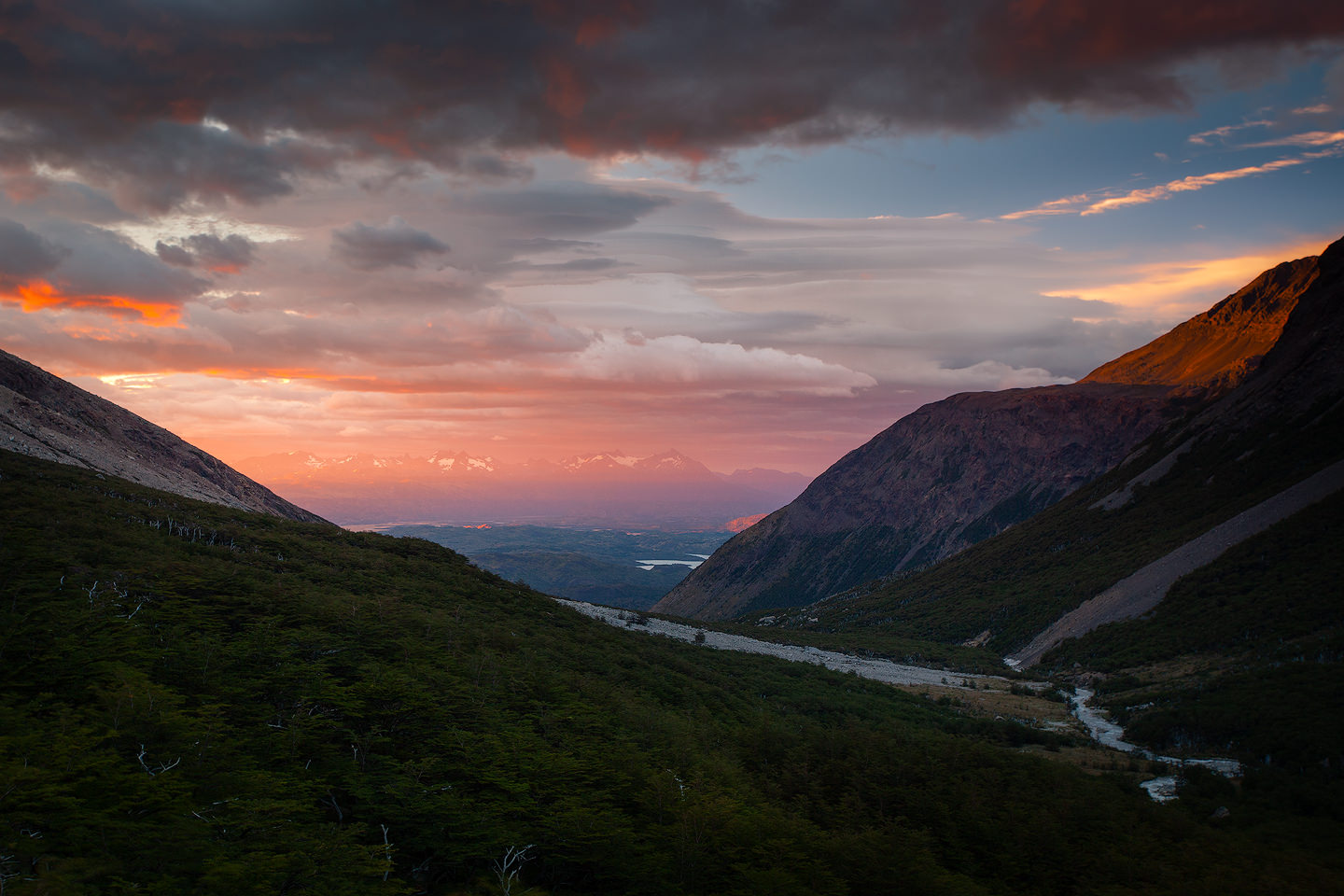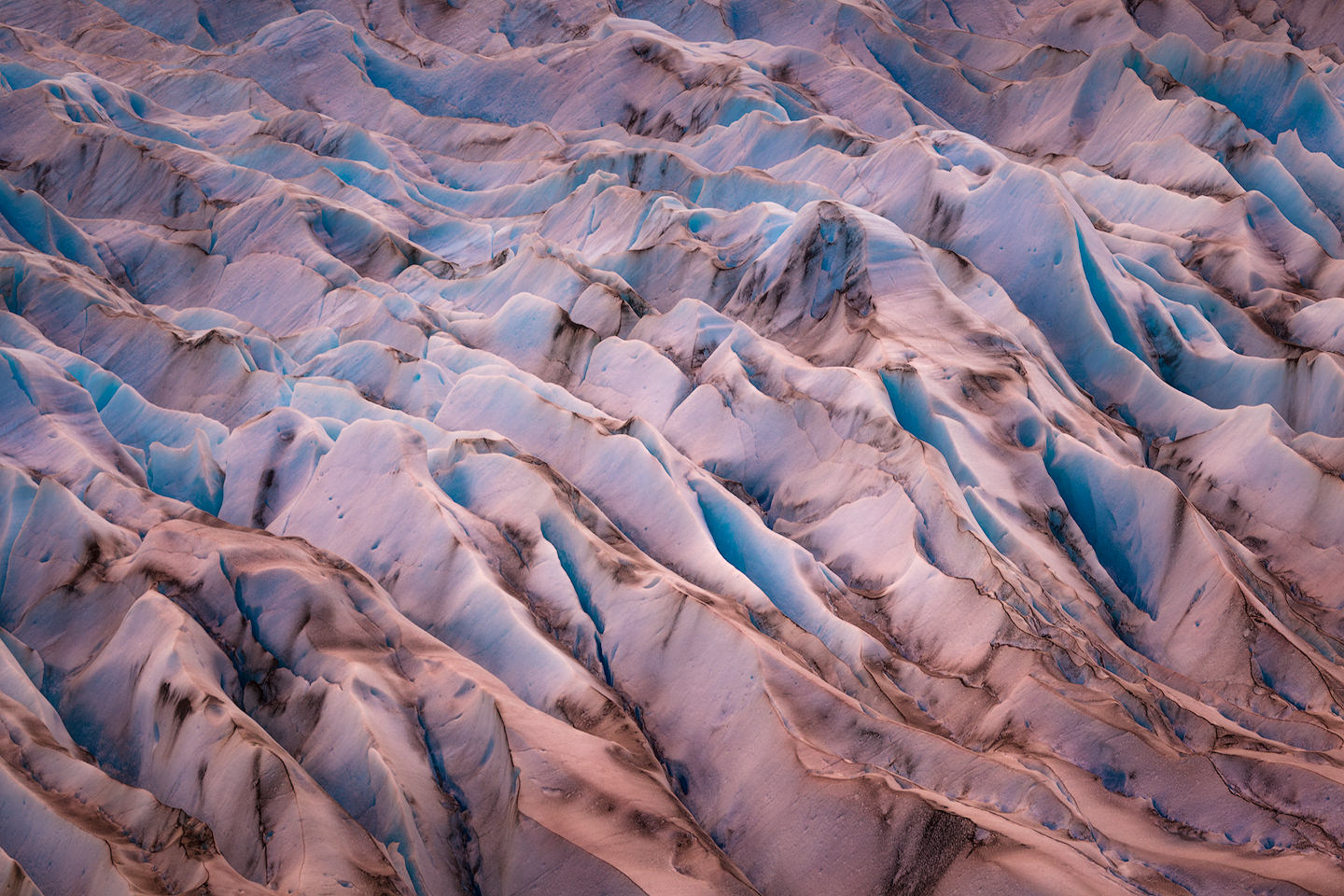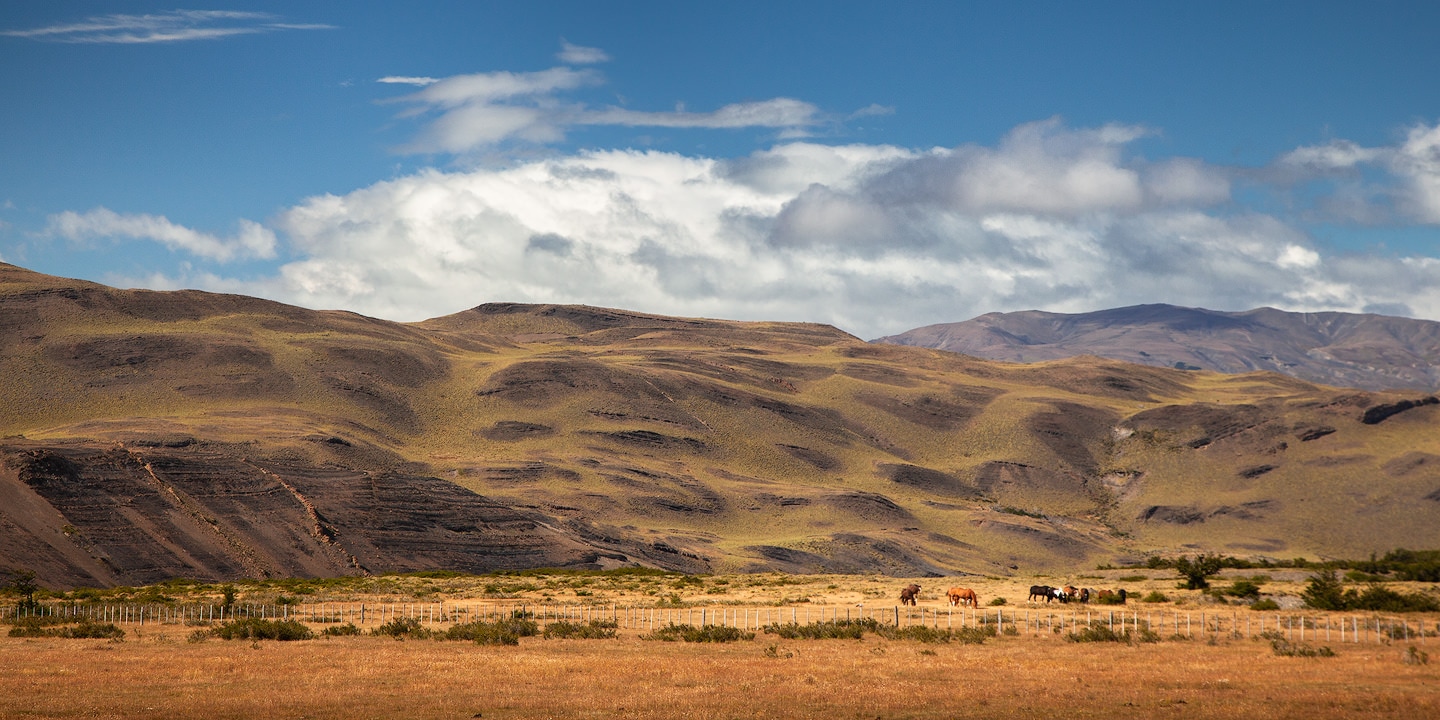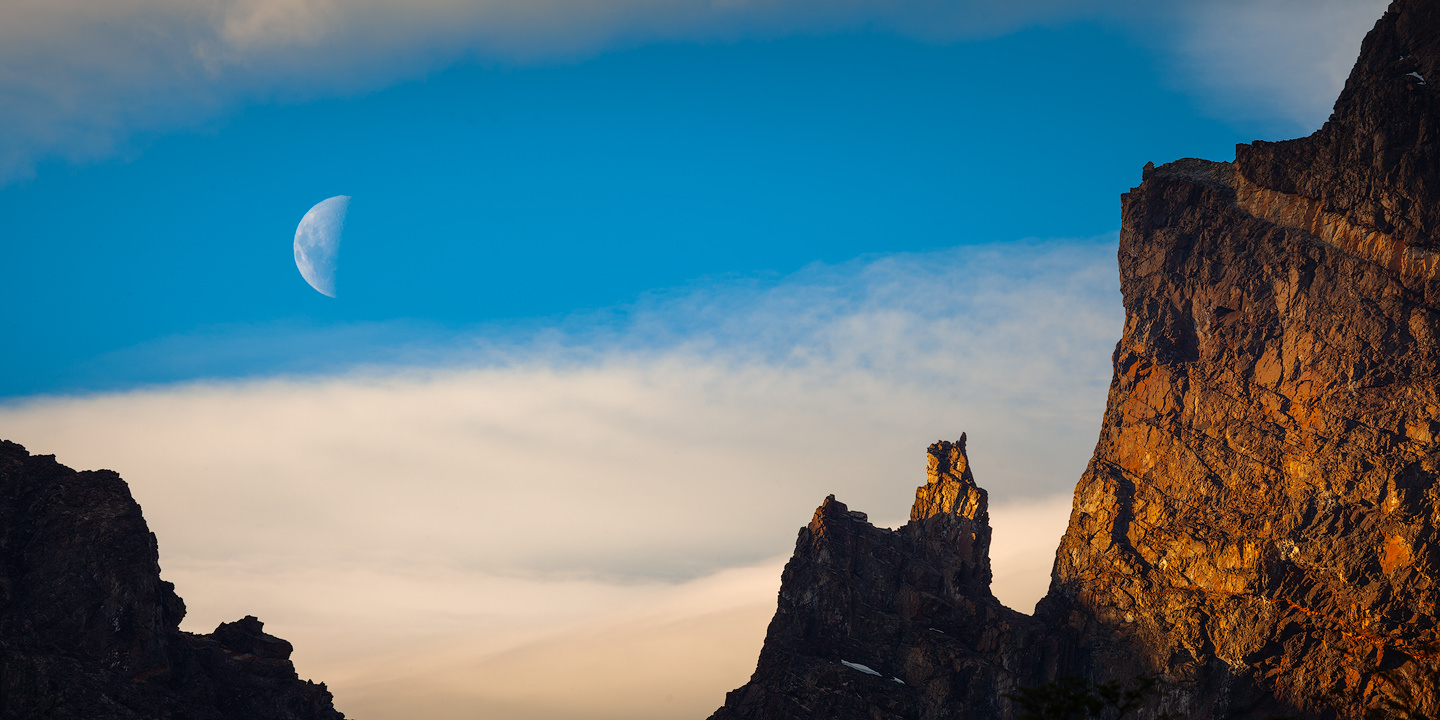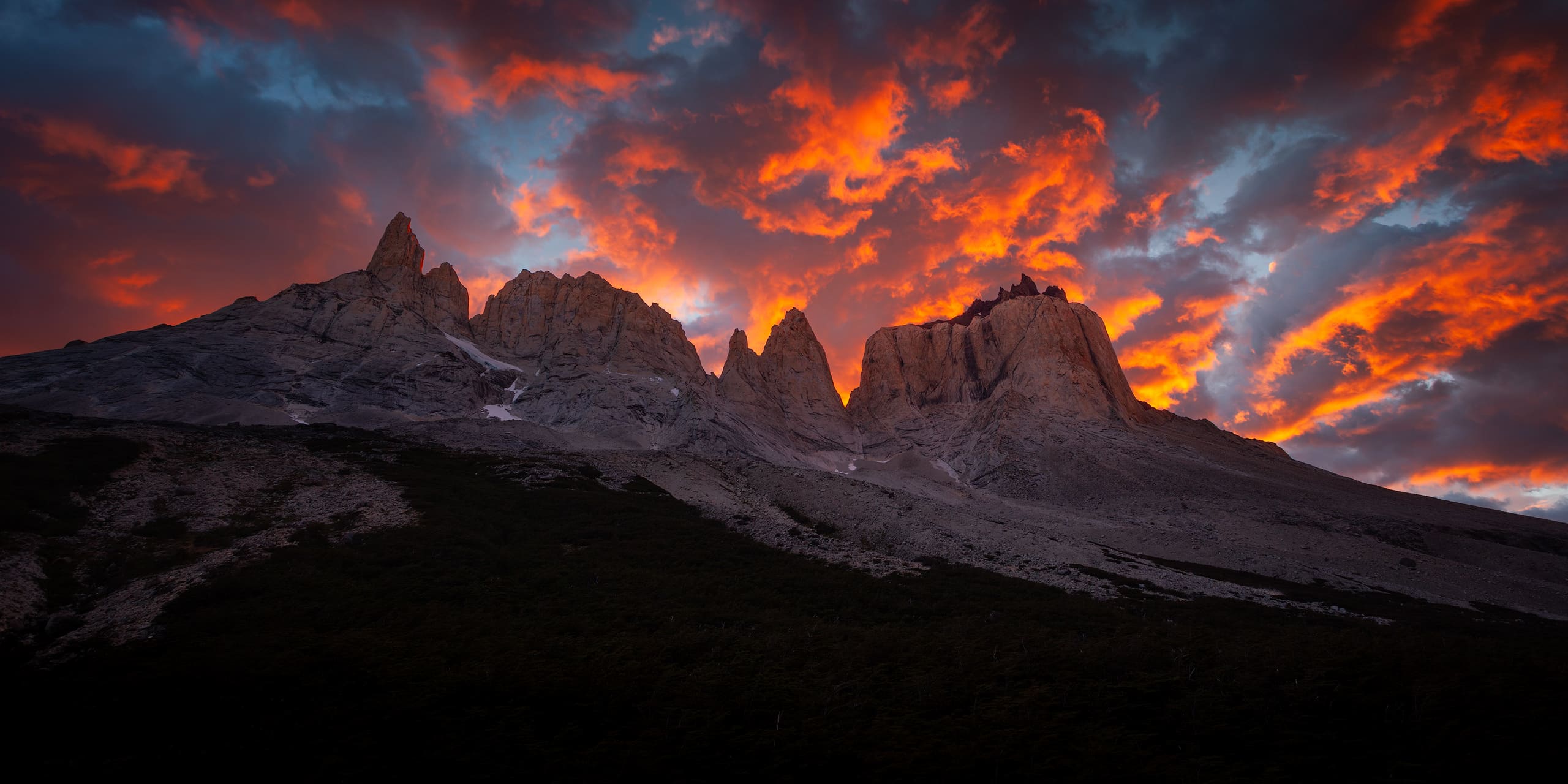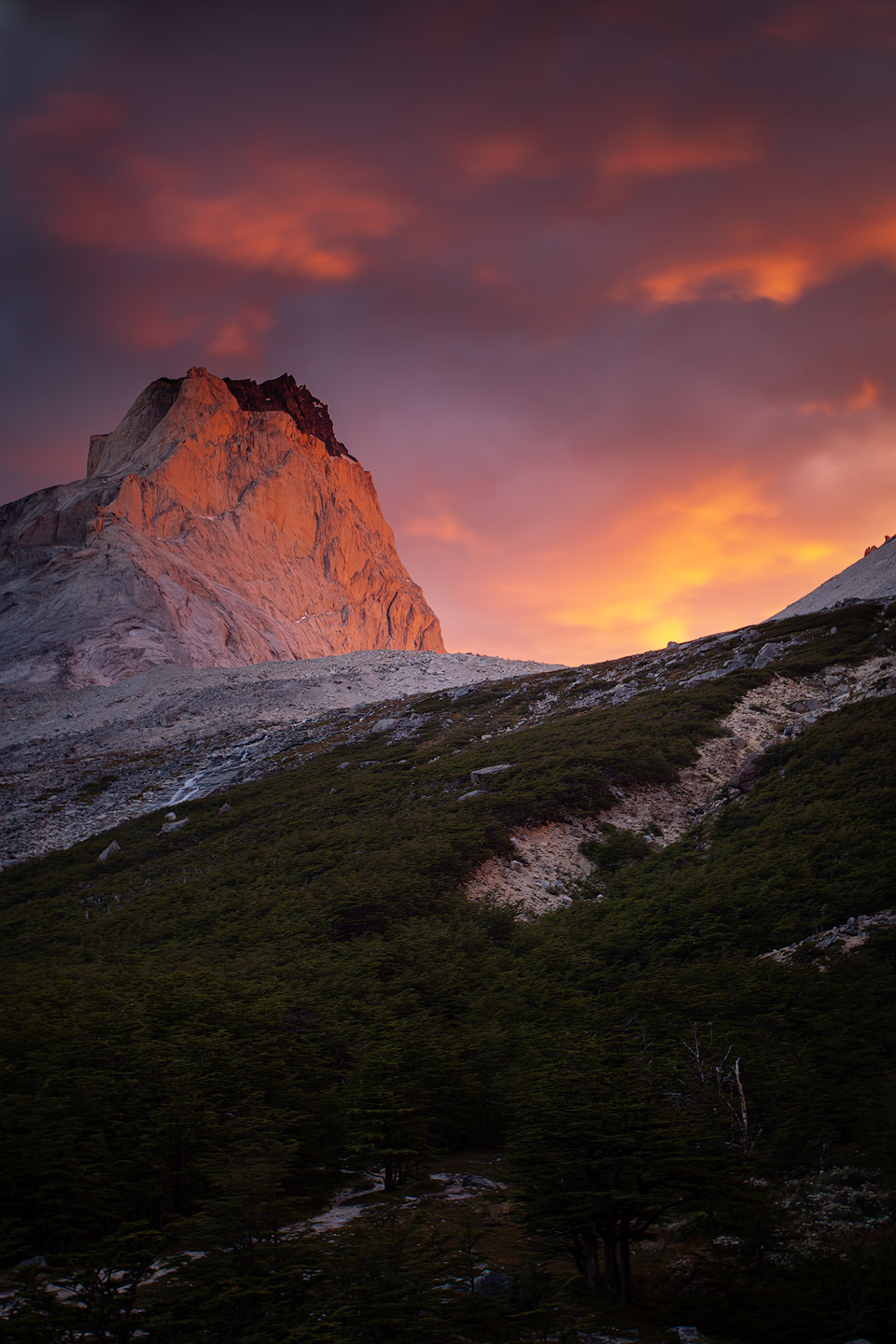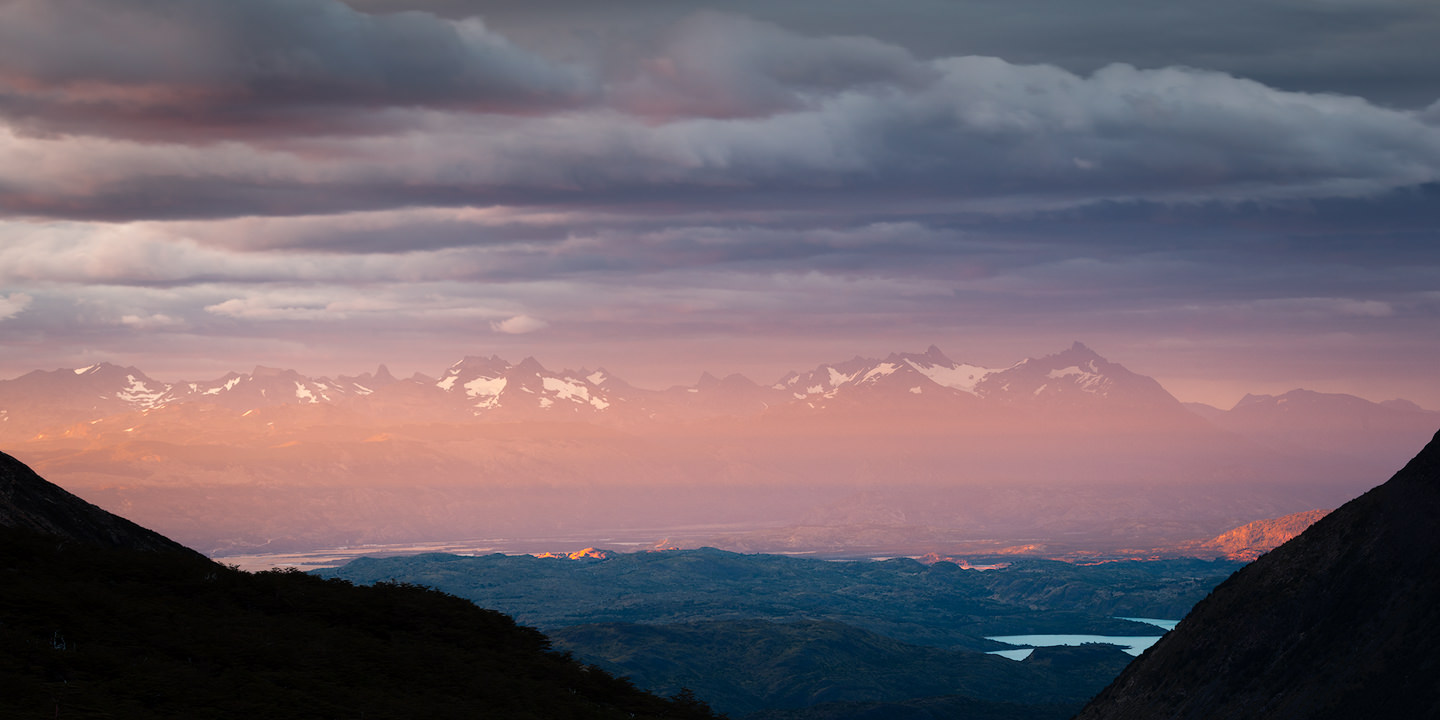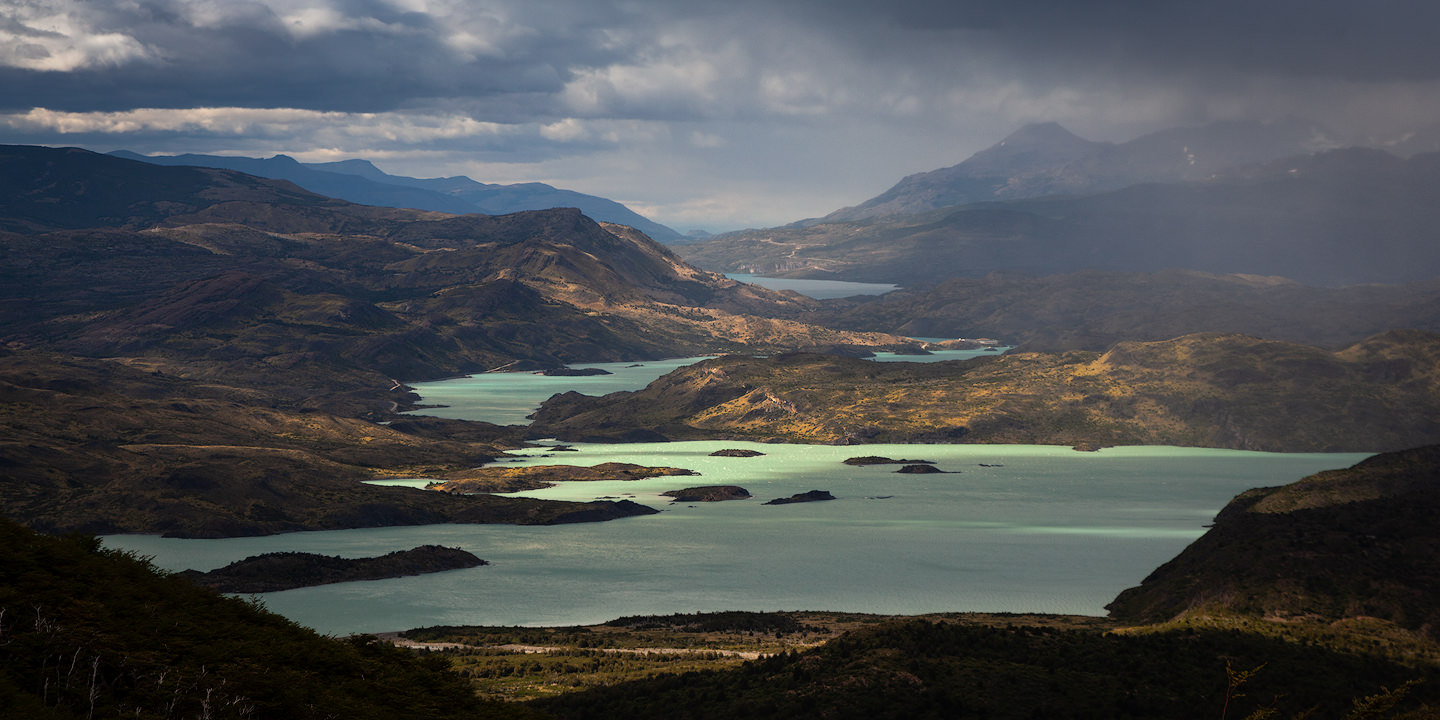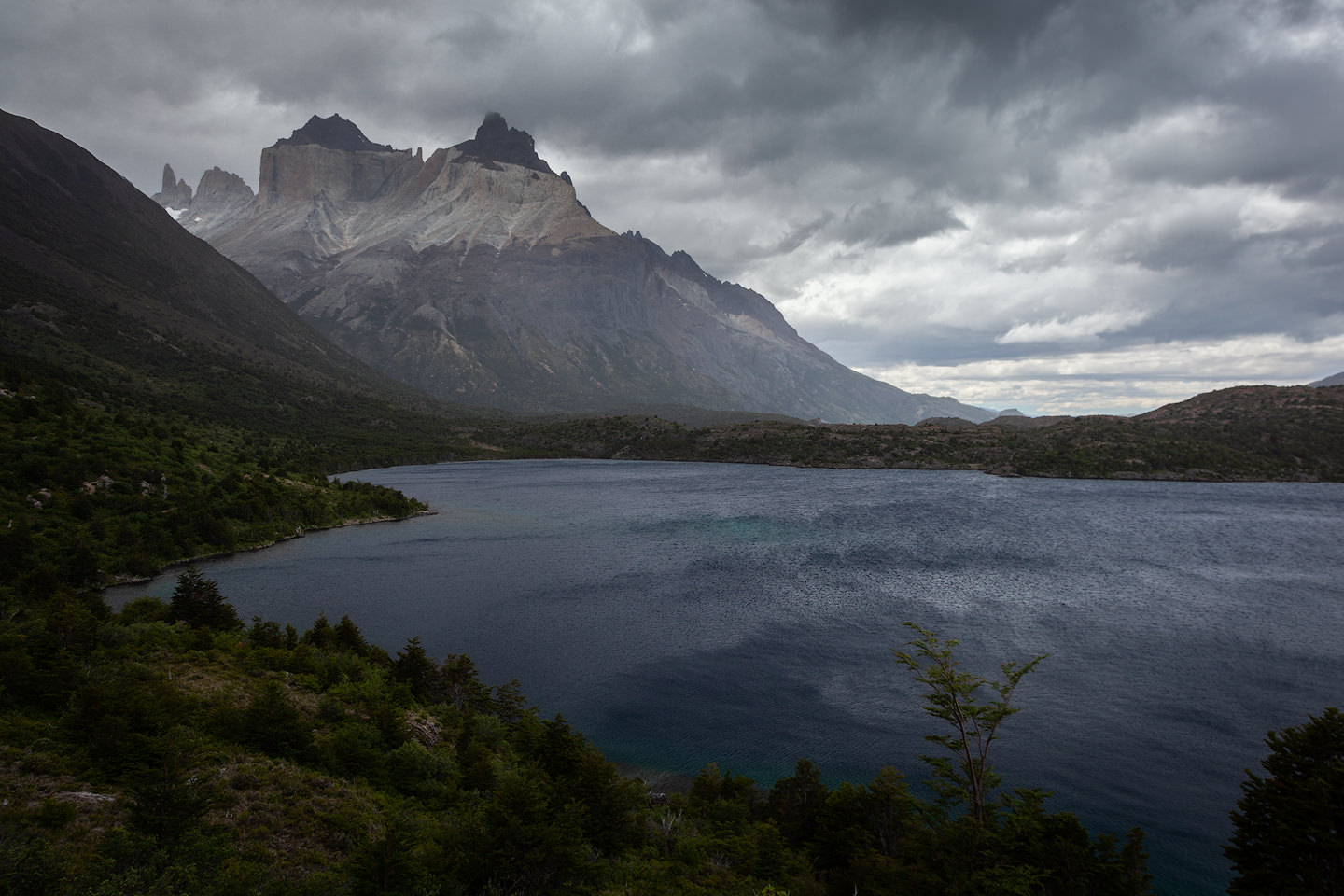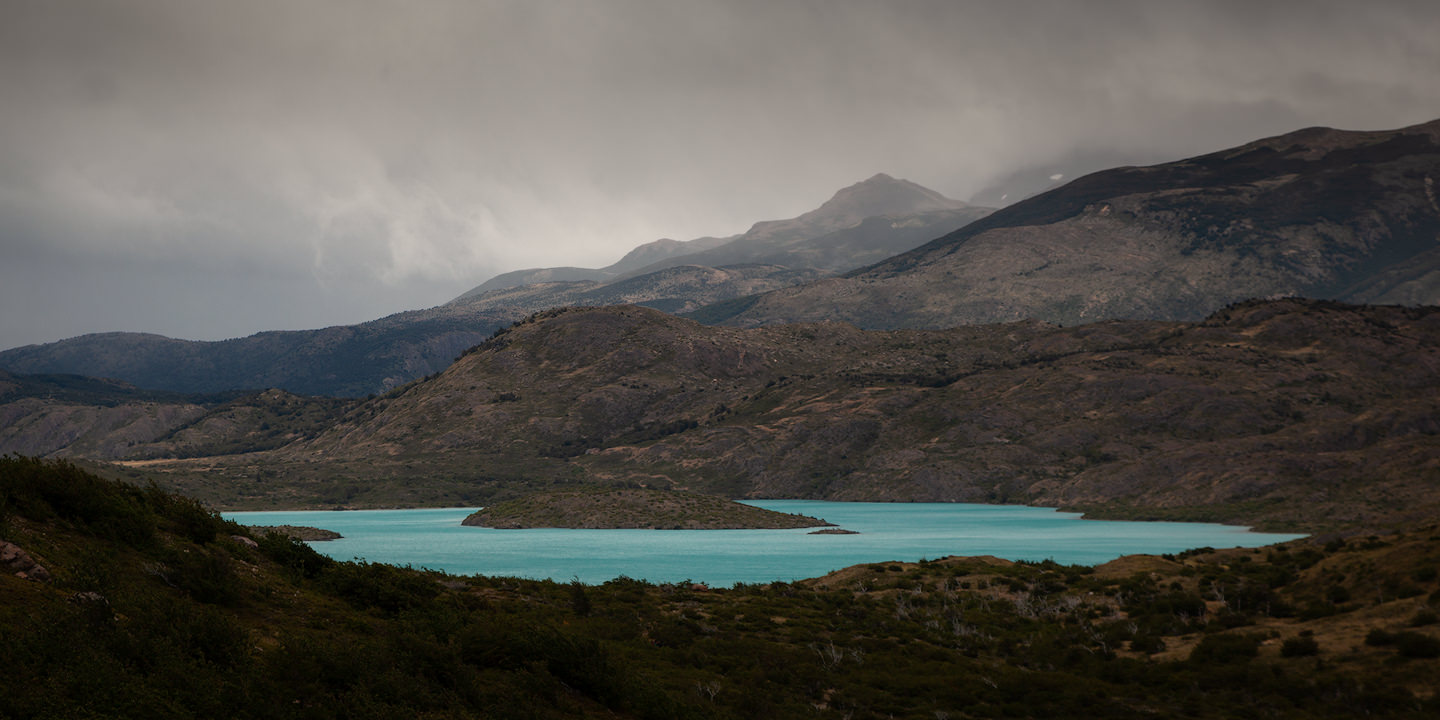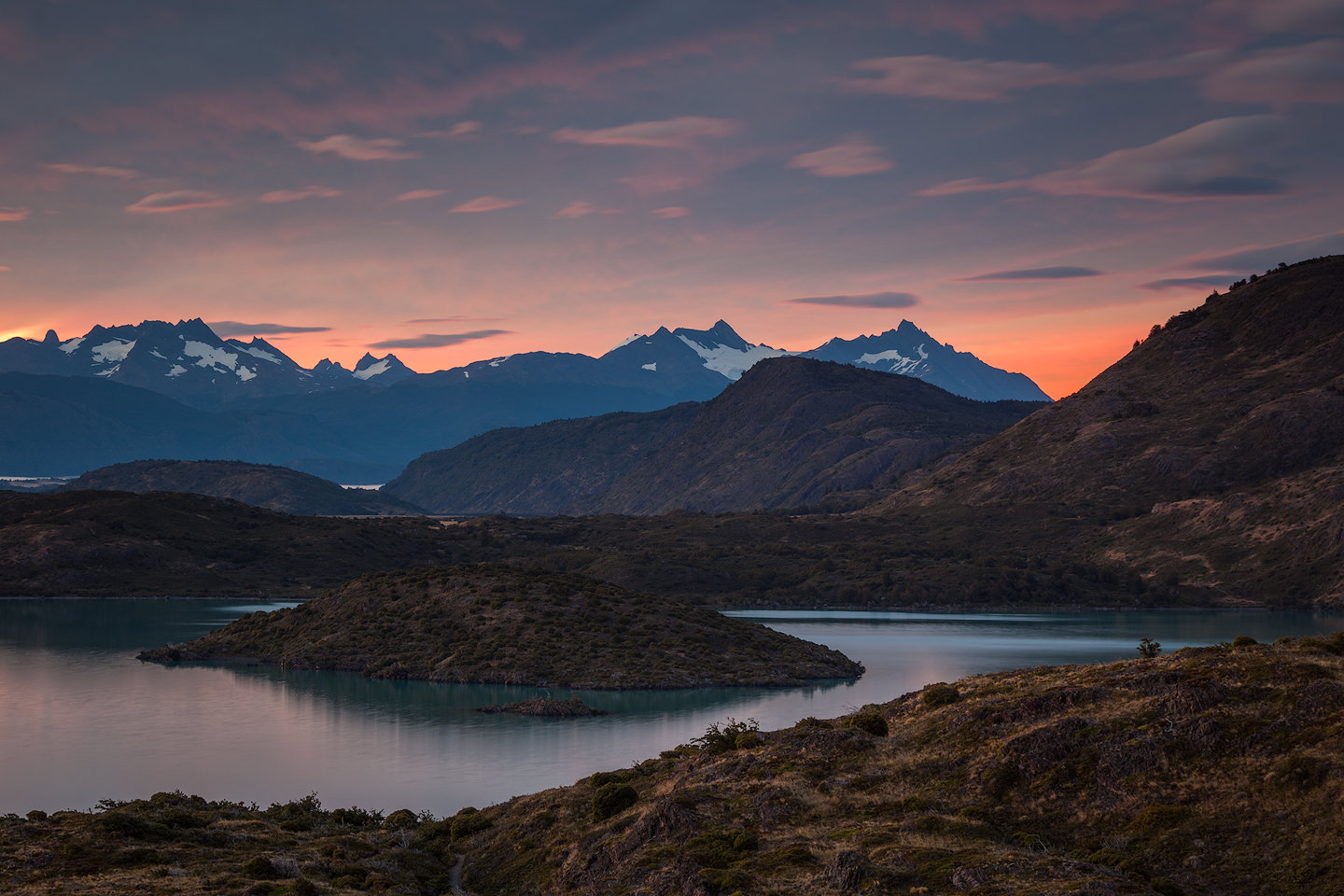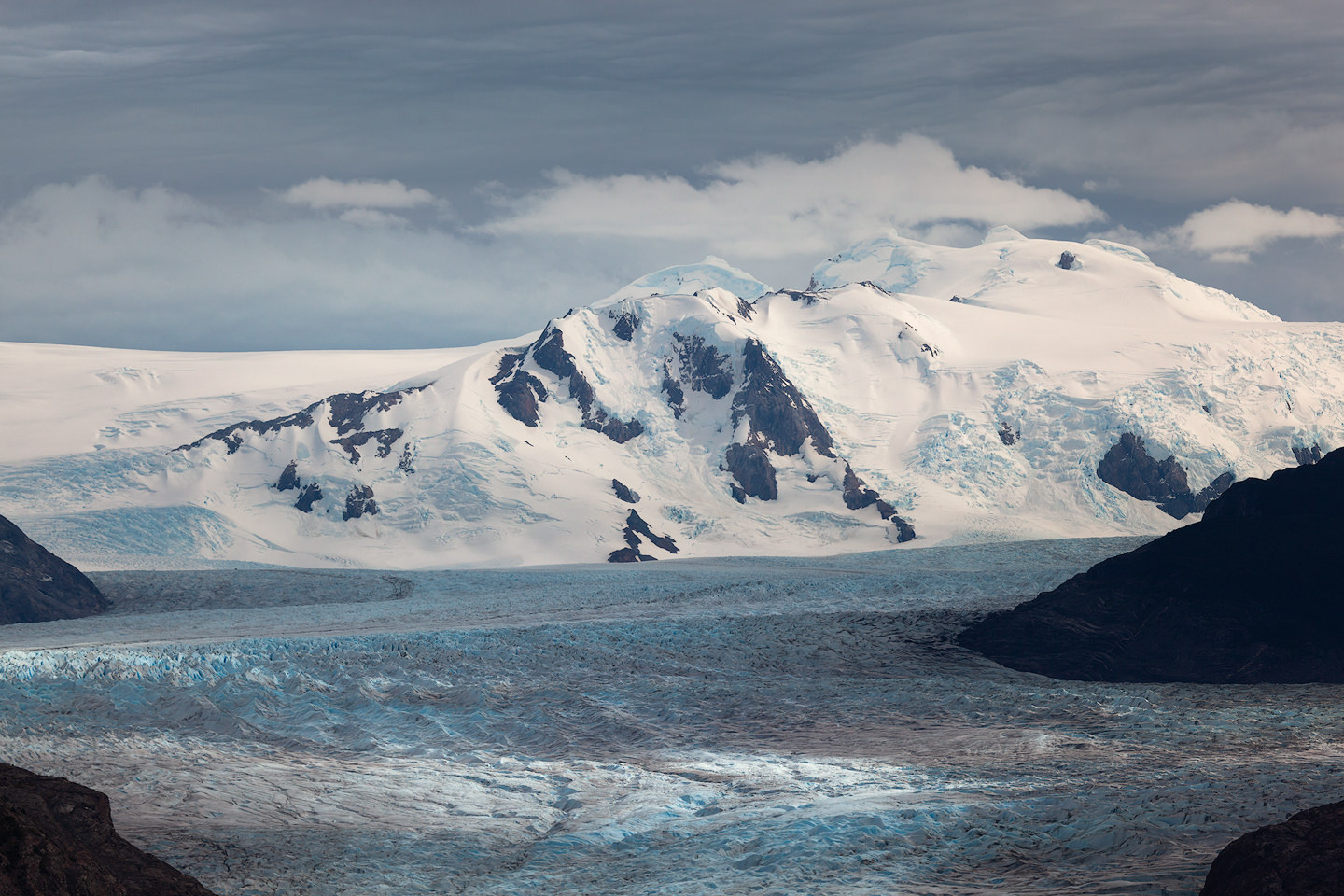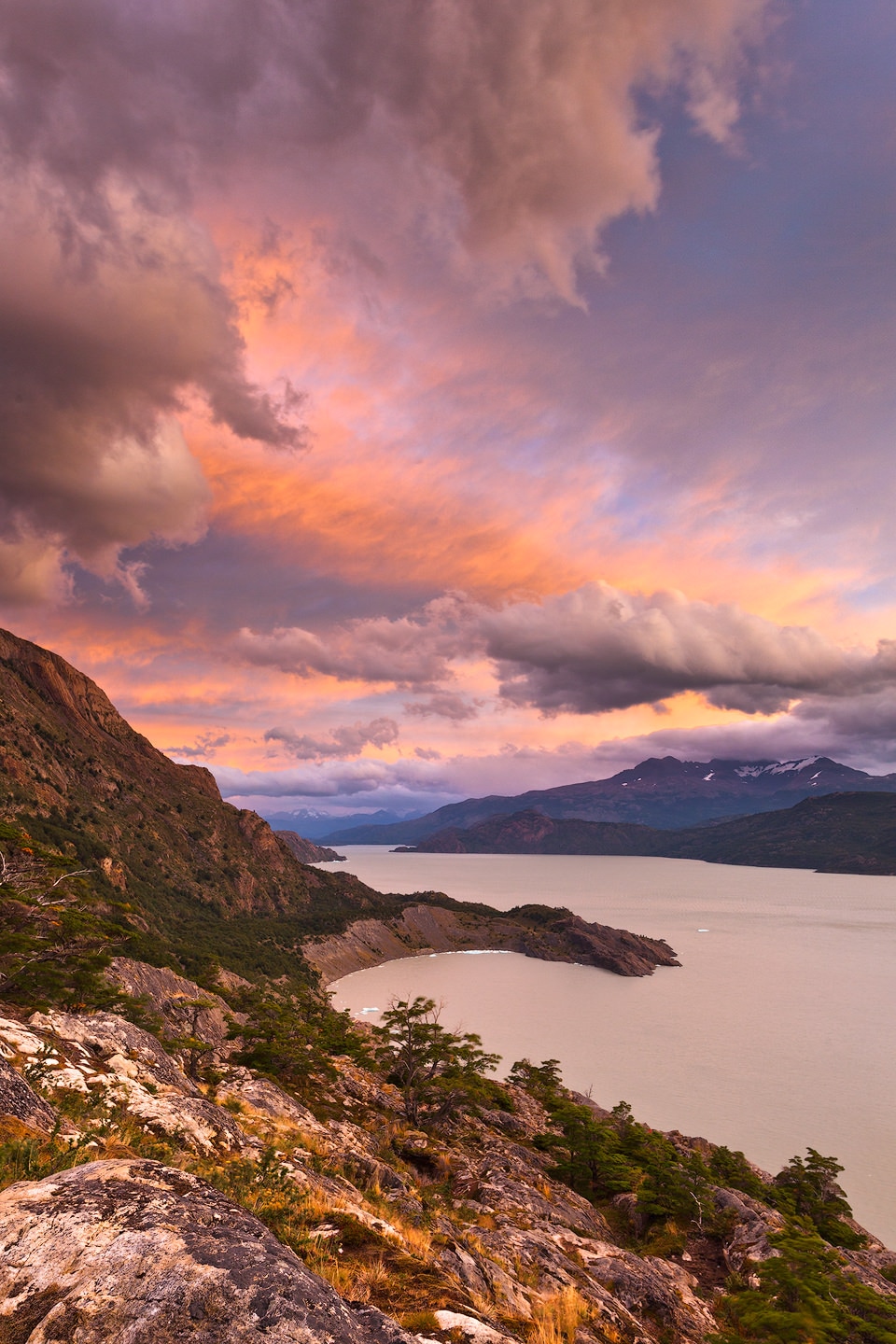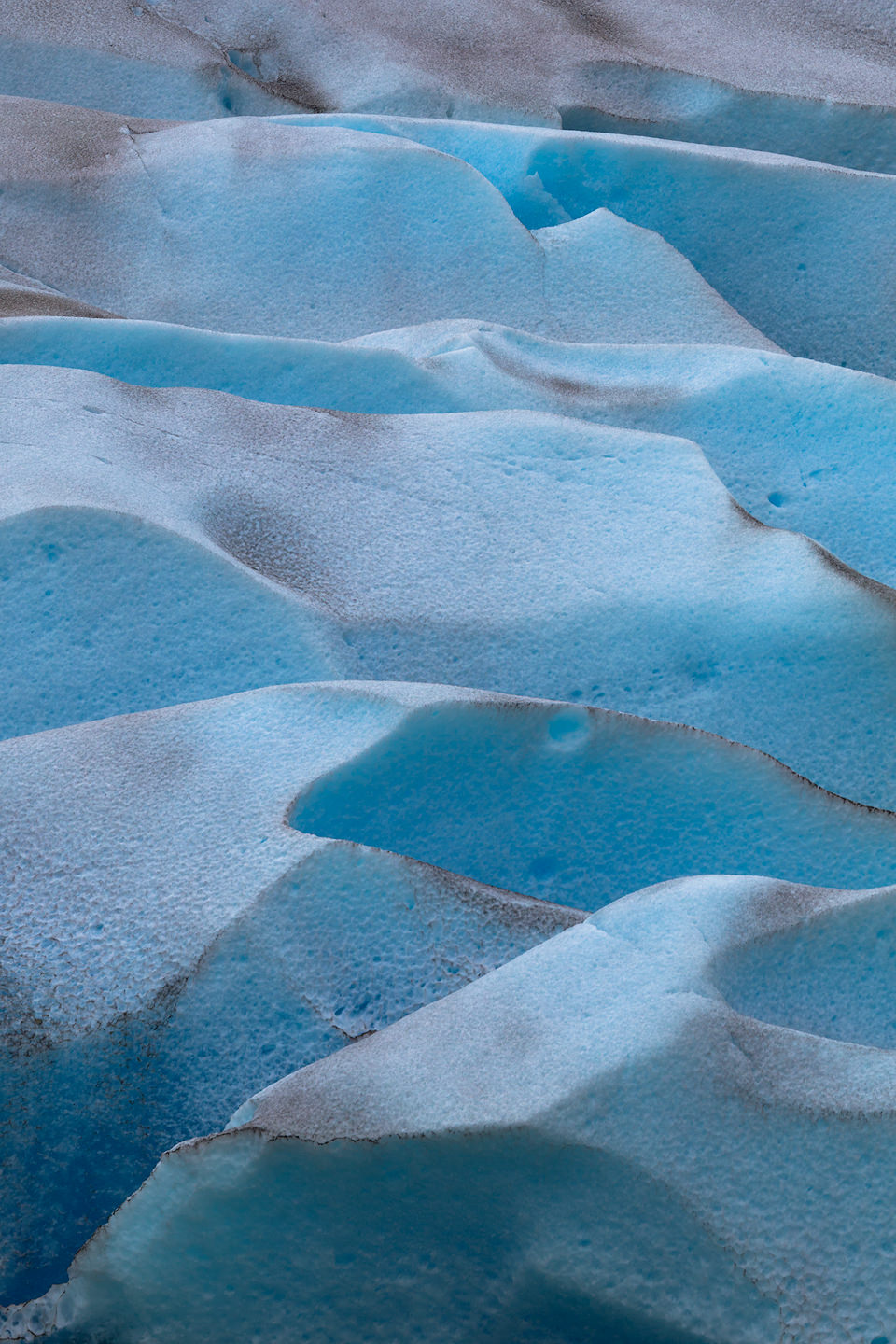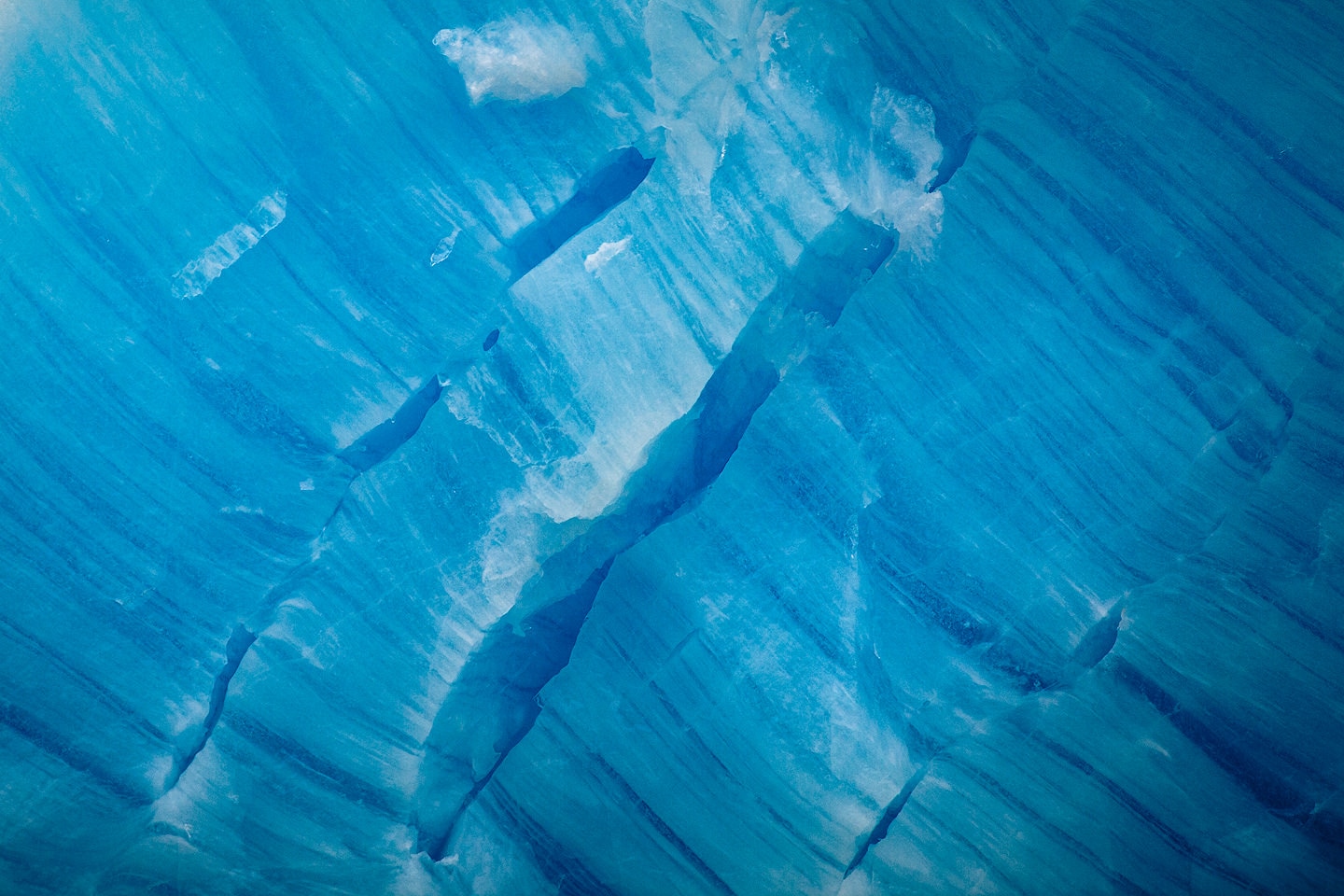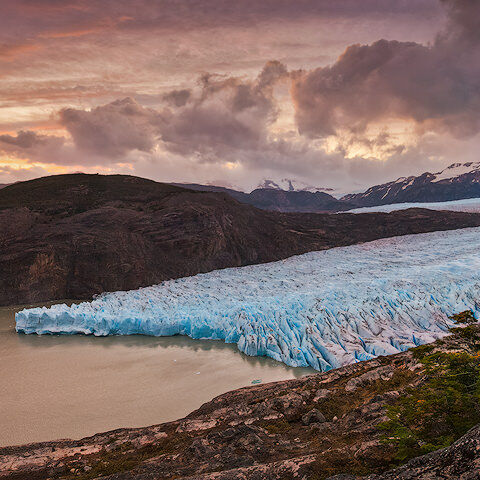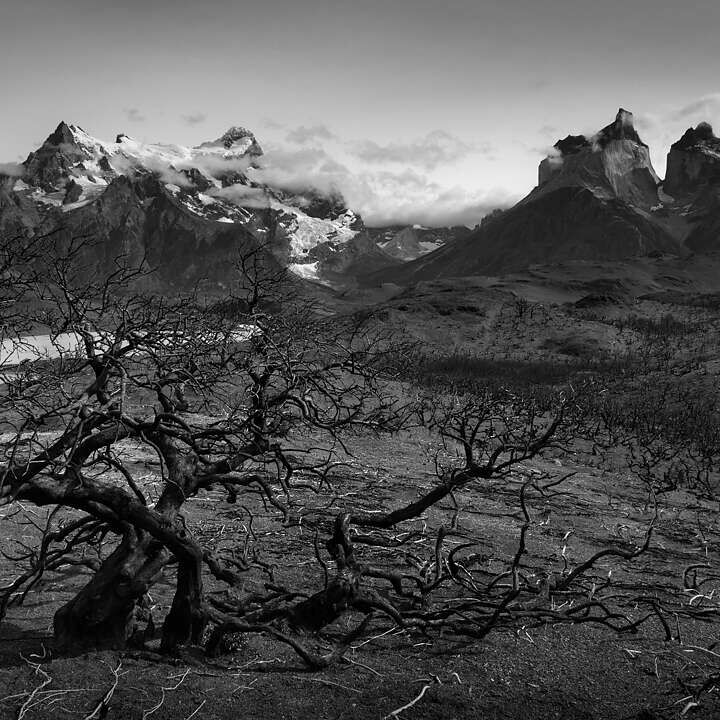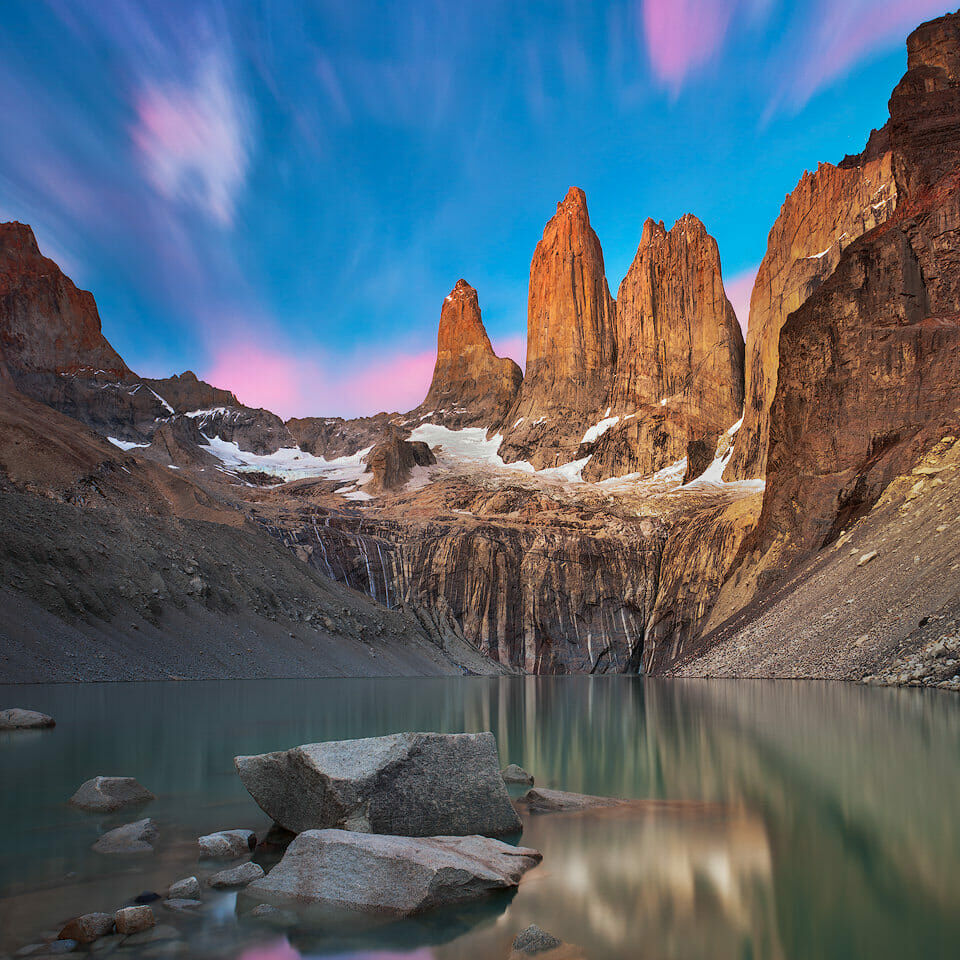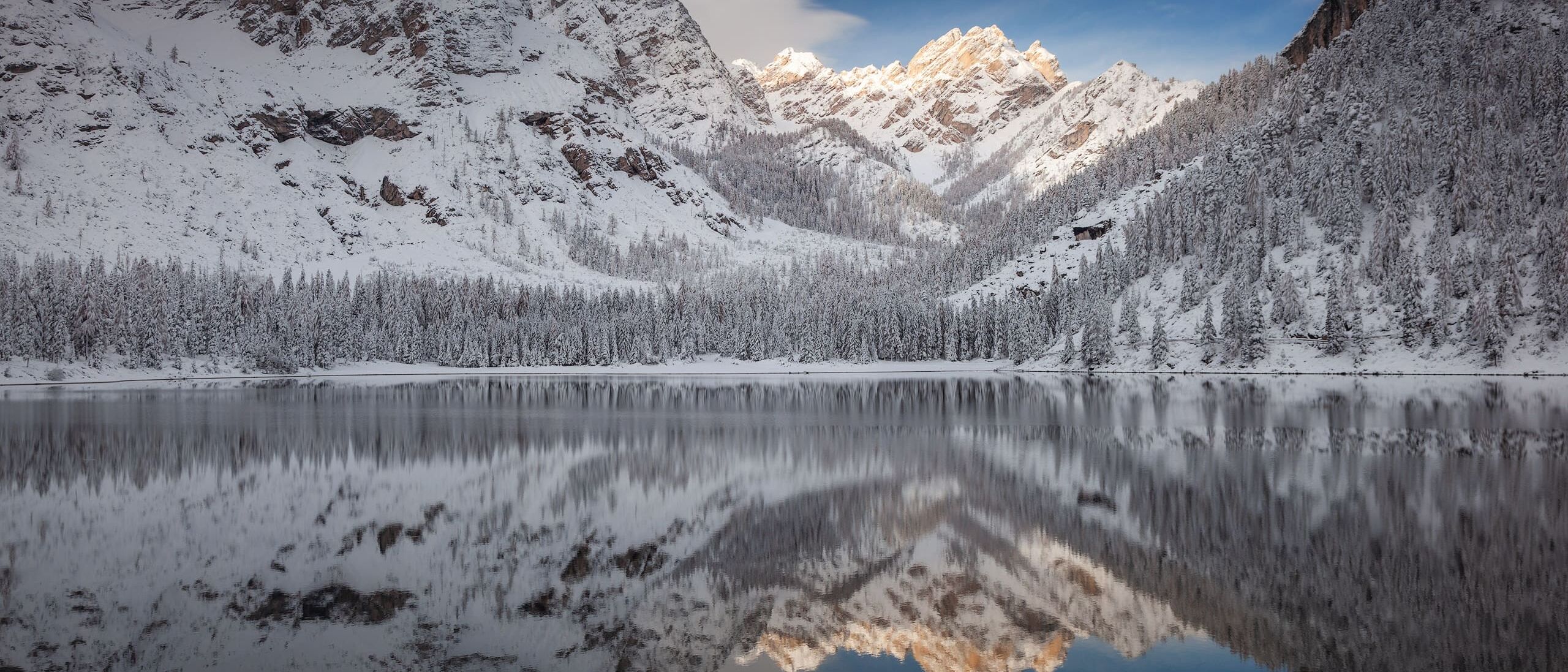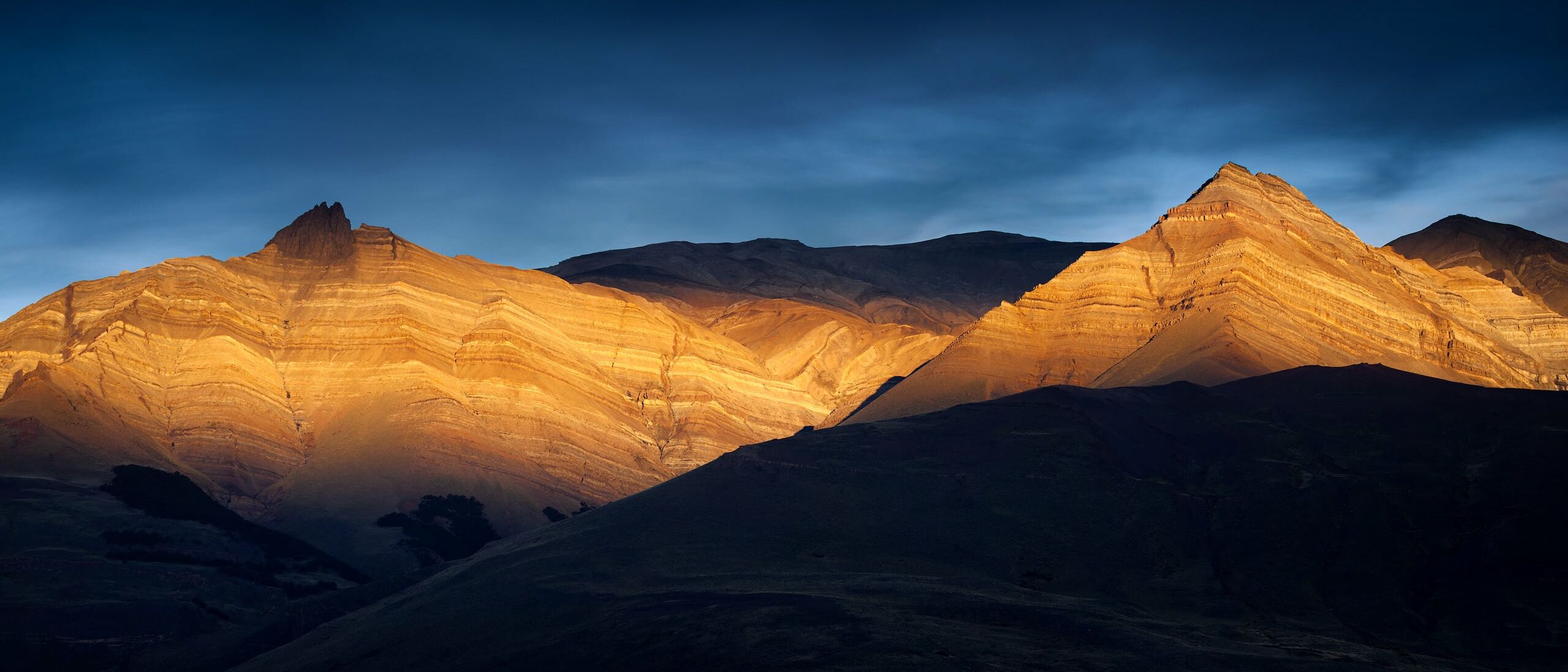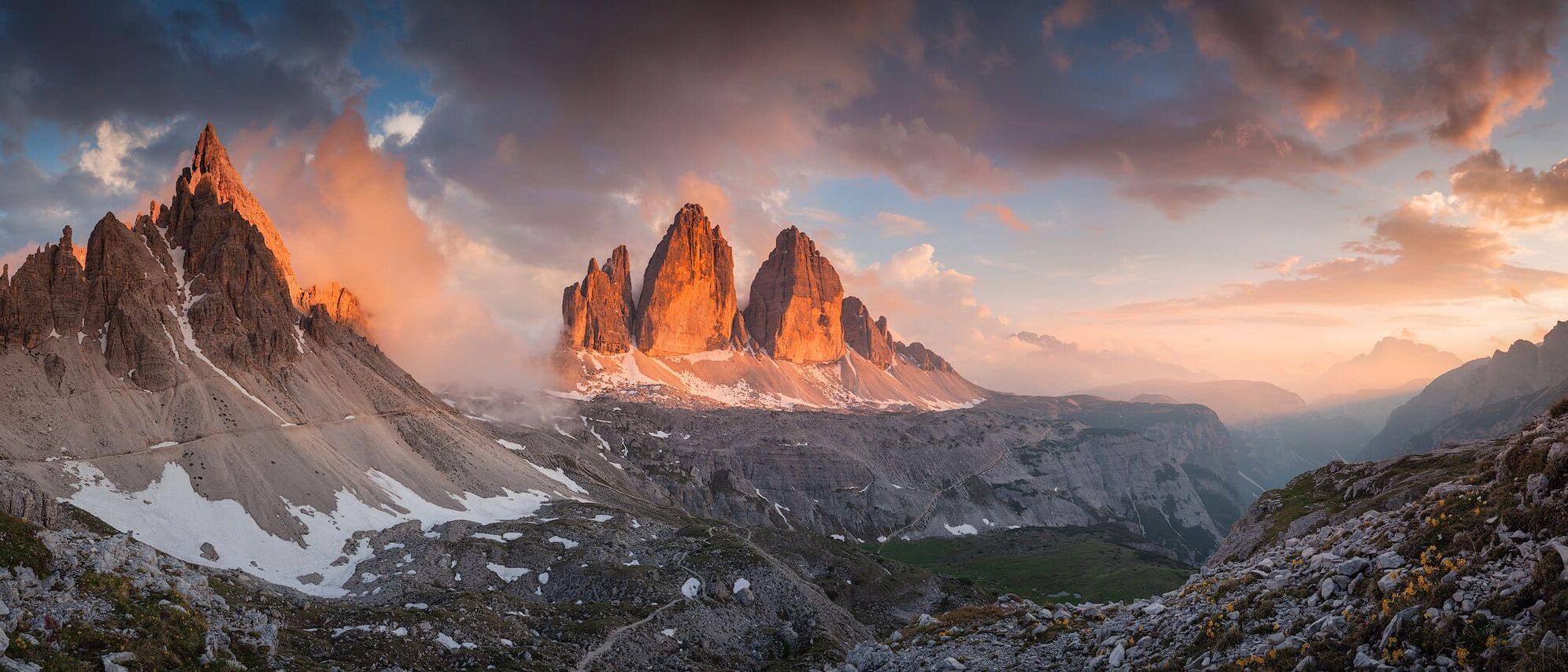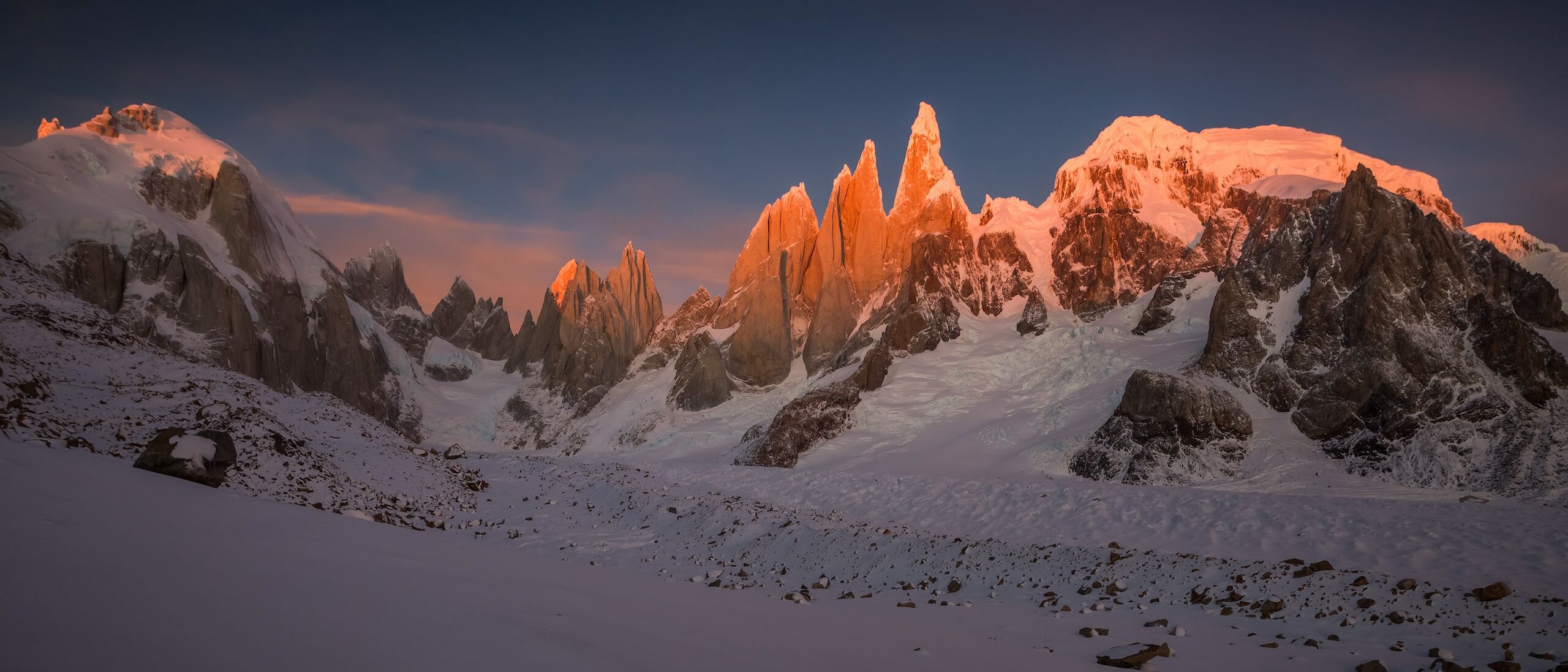We awoke early in our room in a hospedaje in Puerto Natales. It was dark and the wind was howling. Despite the good weather report it seemed like we were up to typical patagonian weather. This was the first time that I had felt a few concerns when I thought about the upcoming days on the W-Trek. We had rented a tent and bought food for 7 days outdoors. I knew that we wouldn’t have the comfort of a warm shower or electricity for some time, but with wind gusts like the ones we could hear outside our trip to the Parque Nacional Torres del Paine might become more uncomfortable than we had expected. Despite the slight feeling of unease we packed our backpacks and got ready for our first real patagonian adventure.
No time to read? Click on the button on the right to view as web story
When we went outside to await our pick-up we were surprised by how warm the wind was. It was still strong, but it didn’t feel as intimidating as it had sounded inside. The dark clouds above us were moving at an incredible speed, but later, when we arrived in the park the weather was fine. Actually it was really hot and we started our walk in a t-shirt. We were excited to finally be walking the classic W-Trek which would take us to all the sights in the park. A few extra days and smart planning ensured that we would see them all in good light but also meant that we had to carry our tent for a few extra miles.
Day 1: Campamento Torres
On our first day on the W-Trek we didn’t mind walking past the first refugio (Campamento Chileno) where most people were staying (apart from the more wealthy ones, that were willing to pay a few hundred dollars for a room in the Hosteria Las Torres). We kept following the path into the valley for another hour until we reached Campamento Torres located about half way into the Valle del Rio Ascencio. After setting up our tent we climbed the last 500m to the look-out Mirador Torres. The view from the top of the moraine on is spectacular. We sat at the lake below the Torres del Paine, amazed by the vista, for quite some time before I started scouting for compositions.
Back in camp I had already buried my hopes for a sunset shoot when we were cooking dinner. The last clouds had disappeared and my legs felt too tired to climb up to the Torres del Paine again. Besides, I knew this was a sunrise location and didn’t want to exhaust myself on the first evening. We went to sleep soon and I set my alarm clock to 4am. It would take me about an hour to reached the Laguna below the Torres and I wanted to be first.
When I woke up I could see lights in a few other tents and I even spotted a few headlamps on the trail to the Torres. I hurried to get up there myself, as not to lose the spot I had scouted the day before to someone else. It turned out that most people going up there were mostly no photo geeks (just regular tourists that must have read about the opportunity to watch a great sunrise in their guidebooks). I went straight down to the water where I had the little lake to myself. The sunrise started with a subtle glow and during the course of an hour or so the faces of the Torres del Paine turned from grey to purple, orange and yellow. When they finally turned back to grey again, it was time for me to leave.
Day 2: Refugio Cuernos
Soon I was back at our campsite and we ate our breakfast. Our oatmeal was actually quite tasty and we had even brought a few hard-boiled eggs. It almost felt like home. After checking the weather report at the park rangers hut (it read: fine) we decided that we wouldn’t have to hurry and slowly packed our stuff. We went back in the direction we had come from, following the path leading out of the Valle del Rio Ascencio. Soon after Campamento Chileno the path steadily climbs a few hundred meters before it suddenly drops steeply towards Hosteria Las Torres. We had to look closely to find the little sign showing us the shortcut to Refugio Los Cuernos that we had read about. We felt relieved. First of all we would save ourselves roughly one hour of trekking and we finally got rid of a group of young people pumping 90’s rock music through their portable speakers. I usually don’t mind listening to Guns ‘N Roses’ “Paradise City” but being in a National Park about 100km away from the next city I found it quite inappropriate.
It was a perfect day for trekking in Patagonia. From time to time it even felt a bit too pleasant. The wind was gone and for much of the time we were walking in our t-shirts.
For a while we enjoyed walking alone on the relatively flat path, but soon it turned out that the W-Trek wouldn’t just be a walk in the park. The resolution of our map wasn’t good enough and what we thought would be a day of straight trekking along Lago Nordenskjöld was actually way more tiring than we had expected. As soon as the path had reached a small hill it descended again just to climb up another one. Our backpacks started to become heavy on our backs (specifically mine, that was not just filled with vital stuff, but with 8kg of photo gear). Our breaks became longer and we had to stop more often. The good thing was, that there were lots of things to see during the walk and the breaks. I guess that even if we hadn’t been that tired we would have stopped just to breath in the scenery. The views of the surrounding mountains and lakes were just breathtaking.
We had been walking for around 7 hours when we finally could see our destination. We had to climb down again, but at least we knew it would be the last time for that day. Refugio y Campamento Los Cuernos is quite a modern hut that also has a small campground. The best sites had already been taken so we had to pitch our tent on one that was not quite perfect (in the end it turned out to be actually quite good – the next morning a few people told us about a party on one of the better sites that had been going on until late that night.). What surprised us about Refugio Los Cuernos was that there were hot showers (and even for free). We didn’t mind the long queues since our bodies were crying for warm water.
I almost had forgotten my main goal of photography after dinner. We were chatting with the couple next “door” when I realised it was getting late. I packed my photo-gear and followed a stream to arrive at Lago Nordenskjöld just in time for sunset. “In time for sunset” this time meant too late for scouting compositions. As the dramatic clouds had already started to catch some fantastic light I barely had time to set up my tripod in the middle of the stream and start shooting.
Day 3: Campamento Britanico
When we woke up the next morning a cold front had moved in. Temperature had fallen significantly and the sun was nowhere to be seen. We started to walk without saying a word. After about 1 ½ hours we reached Campamento Italiano a campsite at the entry to Valle Francés, the dead-end valley which was supposed to be our next stop. A slight drizzle had set in and it looked like it could only get worse. At first we were unsure what to do and even thought about skipping Valle Francés and continuing to the Paine Grande Lodge. Luckily we decided to take a short break and ate some chocolate. Our brains started functioning normally again and we soon started our ascent into the Valle Francés. Given the weight we were carrying it was tough, very tough, and we soon learned why most people on the W-Trek only go there as a side-trip.
It looked like it could rain any minute and in some parts of the park it even must have been snowing – now this was the Patagonia we had heard about! In places the wind was blowing even stronger than on the first day and we had a hard time standing upright.
After a first steep ascent the path was more or less an up and down (more up than down, obviously). The hanging glaciers below Cerro Paine Grande were covered in clouds. We were in constant fear that heavy rain could set in before we reached the camp. This meant that we couldn’t stop nearly as often as we would have liked to. But it was too cold to sit down for more than a few minutes anyways.
We finally reached Campamento Británico after 4 ½ hours of ascent. Logs had been piled around the sites to serve as shelters from the wind. The thought of winds that would call for such protection made us shiver. Surprisingly though, the following night was clear and quite warm. We spent a while star-gazing with a couple that also was staying at Campamento Británico (in fact there were only three tents in the camp and for the first time Parque Nacional Torres del Paine seemed to belong just to us).
Before going to sleep we had arranged to get up for sunrise the next morning, so I crawled out of my tent an hour before sunrise and went to our neighbours’ tent to see if they were ready. Silence. “Did you really think that anybody else would be so crazy?”, i said to myself on my way back to pick up my camera gear. Suddenly I saw lights of two headlamps a bit from the camp. To my pleasant suprise the two had been down by the water preparing tea and coffee.
Day 4: Refugio Paine Grande
The sunrise could not have been more enjoyable. We had followed the path into Valle Francés until we reached a look-out. The show of light was incredible and the hot tea helped to bear the cold gusts of wind. For twenty minutes we couldn’t stop turning our heads as the fast changing light wandered through the valley. I often think back to that morning and it’s not only the pictures I took home but also the company of those kind people (they wouldn’t stop catering me cake and tea) that made this sunrise one of the most memorable ones in Parque Nacional Torres del Paine.
After wrapping the campsite we followed back the path we had walked in the day before. Every now and then we could hear an avalanche crashing down from the hanging glaciers of Cerro Paine Grande. The howling wind painted a mix of sunshine and clouds onto the sky above us. We had just turned onto the main trail at the start of the valley when it began to rain. It wasn’t raining badly, but just enough to make us wet. Low clouds promised more rain and we hurried through the bushland alongside blue and turqoise lakes. We stopped for regular chocolate breaks to raise our moods just to have them lowered again by drizzle and wet gusts. The day became a constant struggle with the elements and we were glad to see the structures of Refugio Paine Grande after about 4 ½ hours. We ate and slept.
Day 5: Campamento Los Guardas
After 4 days on the W-Trek we were starting to feel excertion. Getting out of bed for sunrise was a fight and I would have loved to return to my sleeping bag afterwards, but with another 15km of walking in front of us we had no time to lose. We left our camp at Paine Grande after breakfast and started hiking. The trail was climbing slowly, but steadily until, after 1 ½ hours we reached the first viewpoint of Glaciar Grey. The sun had been shining on and off but most of the time it was overcast and Lago Grey and Glaciar Grey lived up to their names. Nevertheless the view of the glacier and the peaks of the Southern Patagonian Icefield was mindblowing. I could have stood there forever, just watching, but we still had almost two thirds of our way in front of us.
Icebergs that must have been the size of houses were floating in the lake below us, while the sky was filled with clouds of all kinds of shapes.
It took us a total of five hours to reach Campamento los Guardas, located in a small forest 200m above the glacier’s surface. We lost some time at a hut on the shore of Lago Grey trying to book the boat that was supposed to take us back to the other side of the lake on the next morning. Apparently the boat was full, but at least we had made it onto the waiting list. We were a bit frustrated, but too tired to worry too much. Low clouds had rolled in and a strong, icy wind had picked up. After dinner, we tried to enjoy the view of Glacier Grey, but as soon as we left the forest that protected us from the wind we were freezing. Within a few minutes we decided to call it a day and returned to our tent.
Just as I was about to re-enter our tent for the night I saw this yellow glow. First I thought it was light shining through our yellow tent, and didn’t really care, but when I turned around I saw that it was coming from outside. Actually the whole forest around us was filled with this familiar warm light. I knew that this would be my only chance. At first I cursed but seconds later I grabbed my camera gear and tripod, put on an extra layer of clothes and went back out to the rocky ledge overlooking Glaciar Grey.
Day 6: Back to Puerto Natales
The plan for our last day on the W-Trek had been simple: We would walk back down to the shore, jump on the boat taking us to the other side of the lake, from where a bus would eventually collect us and take as back to the town of Puerto Natales. The crucial part here was getting to the other side of the lake, as besides the boat, there was no way out other than returning the way we had come – walking. The boat is a regular tour boat that takes people across the lake to see the glacier. When it’s full with tourists they don’t really care about hikers waiting for a ride back. As you might imagine, being on the waiting list for the boat made us feel a bit unsure about a fast return to civilization.
When we arrived at the dock the next morning we were told that there were no news and that we would have to wait for the boat to arrive, to see whether there would be space left for us. The wait turned out to be a few hours. Hours that were passing painfully slow. We were tired and there wasn’t anything to do really. Playing with little icebergs and throwing stones at the lake was fun first, but soon I was cold. Wind and low clouds had returned and it was drizzling rain and snow. While the weather made the wait less pleasant I guess it was that very same weather that made our return possible. The boat arrived in the early afternoon. Luckily it was half empty, but they still made us wait some more before finally letting us go aboard.
The past six days had been strenuous for both, our bodies and souls. Walking the W-Trek had been a true adventure and it would still take a while before it all would sink in. In the moment we finally boarded the vessel and exchanged our backpacks for life-vests we were happy and relieved, but we also felt a distance between us and the rest of the human world. We were surrounded by day tourists and their chatter about last night’s dinner and for a brief moment we were not sure whether it wouldn’t be better to just return into the wild. But then, just as if he knew about our feelings and to welcome us back in civilization, a smiling crew member approached us with two glasses of pisco sour…
Image Gallery
A picture says more than a thousand words they say. If you don’t feel like reading the whole diary, have a look at the gallery below. Click on the images taken on the W-Trek to open a lightbox and start exploring.
Have you done the W-Trek yourself? Tell me about your expierence! Are you planning to go on the W-Trek and have questions? Feel free to ask any questions in the comments section below!
Torres del Paine: W-Trek
- January 2011
- 6 Days / 5 Nights
- Bus in / boat+bus out
Quick Facts
Information
The W-Trek is the most popular multi-day hike in Parque Nacional Torres del Paine in chilean Patagonia. It takes you into three of the most spectacular valleys of the park and within 6 days you get see all the sights up close and personal.
How to get there
While a rental car gives you the most flexibility, regular buses from Puerto Natales (Chile) and El Calafate (Argentina) take you directly to the park’s visitor’s centers. Once inside you have the choice between hiking and boat tours. Since the park is quite big you might have to rely on irregular bus services to get around.
Where to stay
Parque Nacional Torres del Paine offers everything from luxury hotels to the most basic campsites. Even on the popular W-Trek you can get away with a hot shower per day. Your choices solely depend on your budget and the time you have in advance. Hotels and even mountain refugios quickly book out in high season.
Why Go
The W-Trek is one of the best and easiest options to get to know Patagonia. You’ll get to see some of its famous mountains, its huge glaciers and its flora and fauna. On top of that you get to experience the patagonian winds and weather.
